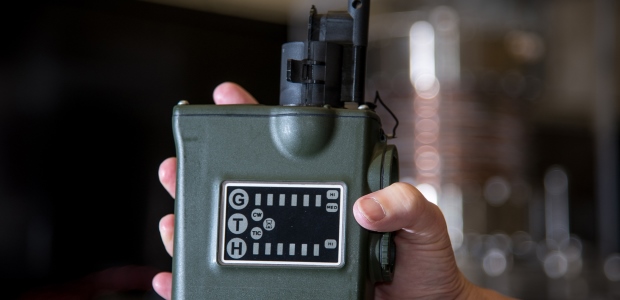
New Device Tests DoD Chemical Detectors
NIST's Threshold Confidence Checker weighs only a few grams. It can be slid onto the top of a JCAD in order to get an exact measurement of the device’s sensing capabilities.
The National Institute of Standards and Technology (NIST) has developed an inexpensive way to test the U.S. military's handheld chemical detectors, a Jan. 17 news release from the U.S. Department of Commerce agency announced.
It says the Joint Chemical Agent Detector (JCAD) has become an important defense tool on battlefields and in war-torn cities recently; a JCAD sounds an alarm and lights up if nerve agents such as sarin or blister agents such as mustard gas are present. The detectors are designed to withstand intense environments and repeated use, but when the Department of Defense wanted to check the devices' sensitivity to chemicals over time, a measurement team at NIST was asked to provide a cost-effective solution.
The result is an accessory called the Threshold Confidence Checker (TCC), which weighs only a few grams. It can be slid onto the top of a JCAD in order to get an exact measurement of the device's sensing capabilities, according to the release.
It says TCCs "demand no special operator training or scientific knowledge and offer a repeatable test that costs less than $1 per use. The test takes only a few moments, and detectors do not need to be taken out of service while the critical components are verified. The small, inexpensive TCCs are vastly different than the first solution that was offered to the testing problem, which involved using a large spectrometer to identify vapors by detecting their chemical signatures in infrared light."
"We realized those wouldn't work very well in this situation," Pamela Chu, the researcher in charge of the NIST team, says in the release. Spectrometers are large, expensive, and heavy, not easily transported to remote locations where troops are often deployed. They can cost more than $100,000 and require specially trained staff.
"The solution we were able to develop instead is inexpensive, effective, and reproducible for other, similar detection equipment," said Chu. The release says the research and development for the TCCs was done by Chu and her team over several years, beginning in 2010, and DoD, which funded the research, has announced it will begin large-scale production of them.
(A Joint Chemical Agent Detector equipped with a threshold confidence checker in black, on top, is shown in the NIST photo by Jason Stoughton that is featured in this news story.)